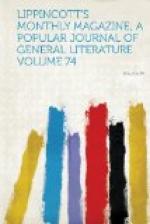In one of the two pictures of her at Slains, if I
remember right, she is represented with the baton
of her office, with which badge she also appeared at
court before her marriage (after this it was borne
by her husband in the character of her deputy).
Her husband was a commoner, a Mr. Falconer of Dalgaty,
whose reported history in connection with her is curious
and deserves to be told, though the old tradition is
moulded into so many different forms that it is very
difficult to disentangle the truth from its manifold
embellishments. Toward the beginning of the eighteenth
century this intrepid and independent lady fell in
love with Mr. Falconer, who at first did not seem
eager to return or notice her affection. High-strung
and chivalric by nature, she did not droop and pine
under her disappointment, but vowed to herself that
she would bring him to her feet. Mr. Falconer
coner left the country after some time, and went to
London. The Countess Mary also traveled south
the same year, and no news of her was heard at Slains
for some time. Meanwhile, she and Mr. Falconer
met, but unknown to the latter, who about the same
time became acquainted with a very dashing young cavalier,
evidently a man of high birth and standing, but resolutely
bent on mystifying his friends as to his origin.
The two saw each other frequently, and were linked
by that desultory companionship of London life which
sometimes indeed ripens into friendship, but as often
ends in a sudden quarrel. Such was the end of
this acquaintance, and one day some trifling difference
having occurred between the friends, a cartel reached
Mr. Falconer couched in very haughty though perfectly
courteous language. These things were every-day
matters in such times, and very nonchalantly the challenged
went in the early morning to the appointed place to
meet the challenger. Here the versions of the
story differ. Some say that Mr. Falconer and his
antagonist fought, but without witnesses; that the
former got the worst of the encounter, and remained
at the other’s mercy; that then, and not
before, the Countess Mary made herself known to
him and gave him his choice—a thrust from
her sword or a speedy marriage with herself.
Others say that it was before the duel that she astonished
her lover by this discovery, and that the choice she
gave him was between marriage and ridicule.[A]
The fact of her marriage, and that it proved a happy one, is certain. Mr. Falconer dropped his own name to assume that of Hay. The countess was a devoted Jacobite and an earnest churchwoman. When Presbyterianism had got the upper hand in Scotland, and was repaying church persecutions with terrible interest, a Mr. Keith was appointed to the Anglican parish of Deer. This was within the Erroll jurisdiction, and it was not long before the zealous Countess Mary came to the rescue of the congregation, who had assembled for some time in an old farmhouse. In 1719 or ’20 she had the upper floor of a large granary




